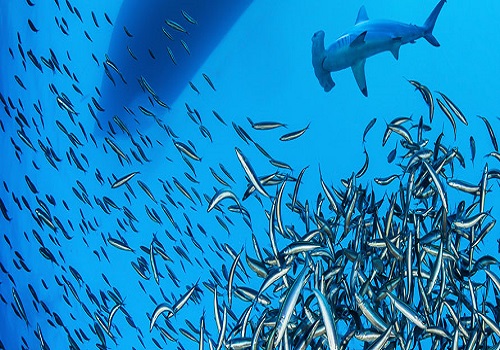Understanding the sustainability aspect of seafood, and the initiatives making the message easier for consumers.
In his book The Third Plate, chef Dan Barber writes about his “Gourmet Disaster” when he serves the wrong kind of fish to a group of food writers and editors. “There are times when a plate of food is allowed to leave the kitchen that should never have been plated, ” writes Barber. But this is not a saga of something over/undercooked. Just moments before this realization, Barber sends through his kitchen door a plate of “Local Bluefin with early summer vegetables from the farm.” His attempt at bringing the farm on to the plate. When the plates come back with the vegetables around the fish eaten, and the fish left untouched, Barber understands his mistake. “You don’t wear the high ideals of sustainability on your sleeve- you don’t gloat about saving old, forgotten seeds of lettuce- and then serve a plate of bluefin. Because, like beluga sturgeon and Chinook salmon, bluefin tuna are going extinct.”
https://www.instagram.com/p/BTxuqcCBUVm/?taken-by=knowyourfish
In June 2017 Hakai Magazine, which focuses on coastal science and ecology published an article titled -“People Don’t Care If Their Fish Is Sustainable.” The article was based on studies conducted by Vancouver Island University and North Carolina’s Duke University which found that sensory attributes were decision driving factors while buying seafood. Similar articles and studies in other parts of the world have highlighted this conundrum. While consumers want to support the right products, understanding seafood sustainability is not that straightforward.
With 85% of the world’s marine population exploited or overfished, the consumer’s choice becomes more vital now than ever. India is the second largest fish producer after China and contributes to 6% of the global fish production. In his article “Be Careful What You ‘Fish’ For: Prioritizing Sustainable Fishing,” Anurit Kanti writes about Indian fish markets and how the sustainability aspect of buying seafood is difficult to factor in. “In traditional fish markets, it is the wives of fishermen who predominantly control the sale of seafood. Within the noisy echelons of the fish market where you are one amongst many fighting to get the best bargain for a kilo of prawns, it is beyond anyone’s thoughts to care about how sustainable the practice of the poor fisherman’s netting technique was, and whether our buying of the fish has a marginal ecological impact on the overall aqua ecosystem and the population of the fish we are buying.” But even this traditional model of buying seafood is rapidly changing in India with a growing demand for processed fish, which will lead to a greater distance from the source and the people who know about the fish you plan to consume.
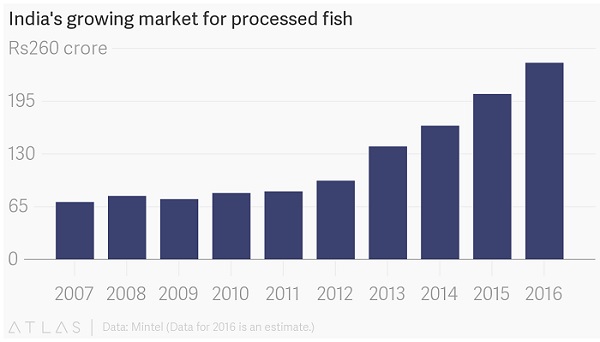
So is it all bad news? Not really. There are many initiatives across the globe which have taken upon themselves to spread awareness among consumers about sustainable seafood choices. Through apps, calendars, sustainability ratings and recipes these initiatives break down the tough decision of making the right seafood choice to an informative visual scan. This article looks at the importance of these visual aids in reaching out to consumers, and the future of seafood. But first,
Why is the sustainability aspect of seafood difficult to comprehend?
As the Hakai Magazine article points out, terms that are used to address sustainability are often not strictly defined, and therefore open to interpretation. “Timothy Fitzgerald, the director of impact at the Environmental Defense Fund’s Fishery Solutions Center, an advocacy organization, says that definitions are inconsistent throughout the fishing industry—in his opinion, this is one of the biggest challenges to creating a sustainable fishing industry,” the article elaborates.
A direct result of this is that consumers don’t know how to translate their sustainability goals into actions. In the case of seafood, this becomes even more complicated as there multiple factors to consider such as- stock status, methods used to catch the fish, packaging, and transportation. Adding another layer of complexity is the fact that these factors change based on the season, change in regulations and with newer market developments.
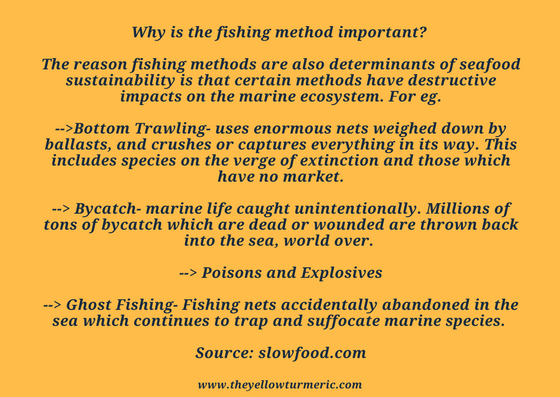
The most prominent reason, however, seems to be a lack of awareness when it comes to the oceans. An analysis of studies on consumer understanding of sustainable seafood through ecolabels found that people were concerned about issues such as industrial pollution, litter and oil when it came to the ocean. Fisheries ranked lower on the totem pole. Marine Biologist and co-founder of the Know Your Fish initiative Pooja Rathod says that part of the problem stems from the fact that people don’t have much of an exposure when it comes to the ocean life. “How do you evoke emotions for something you have never witnessed? When something happens on land, the impact seems to be far more imminent. When it comes to the ocean, it happens under water. A lot of the people have no diving experience to conjure up an image.”
Adding to the complexity conversation, Pooja shares that there is a lot consider.” The general problem with sustainability is its very complex. It changes from coast to coast. The way the fish are caught, the attitude, the policies- everything varies in India from one state to another. Which means traceability becomes a problem.”
So can we all seek solace in the fact that if an acclaimed chef made a mistake, so can we? Not really. FYI, the incident was mentioned at the beginning of Barber’s entire book-section on seafood, so our excuse doesn’t stand a chance. But with the availability of seafood guides, looks like we no longer need an excuse, to begin with.
Role of user guides in making sustainable seafood choices. An overview. Click To TweetInitiatives in India; Know Your Fish and In Season Fish
What if I gave you a list for each month which pretty much outlines your responsible seafood choices? This is what the team behind Know Your Fish, marine biologists Pooja Rathod, Mayuresh Gangal and Chetana Purushottam, have created. Know Your Fish’s monthly recommendations for the west coast highlight preferred seafood choices for the month and choices to avoid. Their colour coded vulnerability score helps consumers understand, in one quick glance, which of the species are more vulnerable to over-exploitation. Along with the monthly suggestions their ocean sensitive seafood calendar for prominent species gives year-round recommendations, highlighting months in red when consumers should avoid a particular fish. “It started over a conversation between my colleague and her friend when he pointed out that are so many green labels guiding us when it comes to food, but there is nothing when it comes to seafood. We realized being marine biologists, we know what is going on, we have been collecting data from fish landing sites, so we could use the information to create something for people to guide them with seafood.”
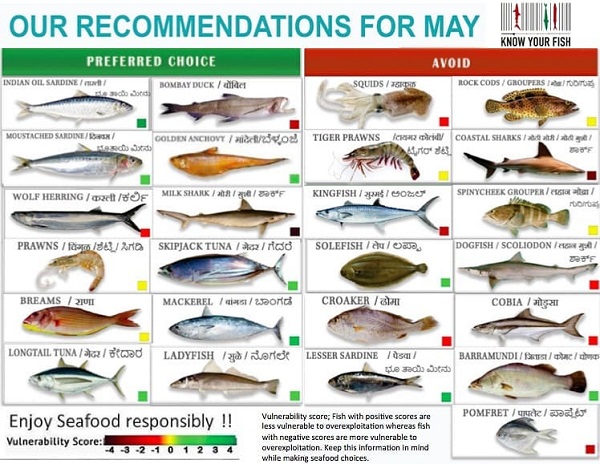
So what went into making these calendars? “We created a list of about 25 species of fish which are commonly eaten and then dug up literature about when these fish breed and what are their trends. We looked at whether their populations are increasing or declining. Also, because we collect data from the fish landing sites, and there are different methods used to catch the fish, we try to give them a score based on how they are caught,” says Pooja.
Pooja adds that while constructing the message, the team wanted to come up with something that was easy to comprehend, concise yet informative. This what they had in mind when they worked on the calendars.
In Season Fish, similarly provides information on sustainable seafood choices for the east and the west coast of India. Created by marine geographer Divya Karnad, Chaitanya Krishna who is a wildlife biologist, filmmaker Sara and creative head Anil Adireddi, this team spreads awareness about seafood through recommendations and market visits. If you stop by the In Season Fish website, you will find monthly recommendations, and choices to avoid. The initiative promotes diversity in seafood choices, thereby reducing the pressure on a few species. On their Instagram feed, for example, they share recipes for seasonal seafood specialities, encouraging consumers to diversify their seafood consumption. In Season Fish also works with restaurants and chefs to promote these ideas. Through their Fishplorations, they showcase the diversity available in fish markets, bringing consumers a step closer to identifying these species.
https://www.instagram.com/p/Bh_BBTOnZaG/?taken-by=inseasonfish
A Global Perspective
Monterey Bay Aquarium’s Seafood Watch, Marine Stewardship Council and the Good Fish Guide of Marine Conservation Society (MCS) are some examples of global initiatives which help consumers make better seafood choices. Rajina Gurung who is the seafood sustainability advocate in the Fisheries and Aquaculture team at MCS shares that their goal with the Good Fish Guide was to break down the complexity of the issue.“We display our ratings through a familiar and often applied traffic light system which provides instant recognition of the most sustainable seafood available (rated green), the most unsustainable seafood available (rated red for fish to avoid), and amber for seafood which we recommend people should aim to eat less of,” says Rajina about their guide.
So what should initiatives focus on when they are trying to engage the consumer in a dialogue on sustainable choices -“The messages should be easy to follow and relevant for different audiences and geographies,” Rajina comments.
Rajina elaborates that the sustainability conversation will vary depending on where you have it. Unless consumers have enough information, the choice will not be straightforward. “Where a fish has been caught or how it has been farmed can make a huge difference to the sustainability aspect of the product, and its impact on the marine environment. For example, there are at least 14 different cod stocks in the northeast Atlantic alone, and some are doing much better than others. The capture or farming method used can also differ to a large extent. This difference will translate to a very low or a very high impact on other marine life and/or the environment.”
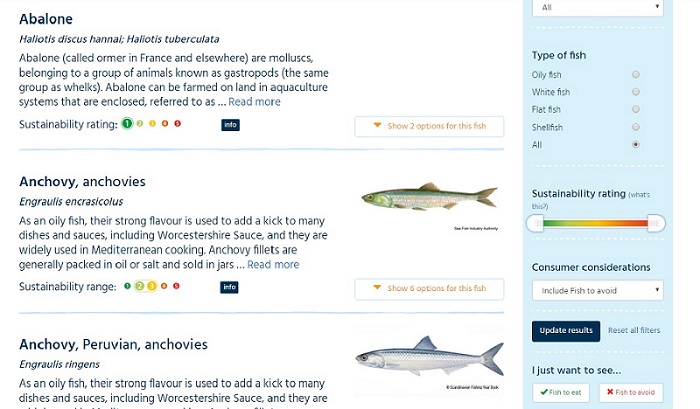
If you are reading all this and wondering- surely there can be easier ways to identify what is right, well there are. The presence of ecolabels such as the blue tick of the Marine Stewardship Council is an example of this. The tick symbolises a product which can be traced back to a sustainable source. “But keep in mind that certified wild caught or responsibly farmed seafood currently applies to the minority of global production (approximately 10-20%), and that means we still need appropriate guides to help us through our seafood purchases in markets,”says Rajina. Rajina weighs in on some of the other important points when it comes to ecolabels. “Ecolabels make it very simple for consumers to identify sustainable seafood. However, knowledge of eco-labelling amongst consumers is limited. The other aspect is information provided by the labels. In many cases, details of the specific capture or farming methods and stock areas are not displayed. Instead, more than one possible area and method are listed. This makes it difficult for consumers to make a fully informed choice, ” she explains.
Criticism and Coffee
“We already see an increased interest for sustainable seafood in Asia”, says Monica Jain founder and executive director of Fish 2.0. Fish 2.0 connects sustainable seafood businesses with investors, encouraging ventures that are working towards making a change.
A common argument against these seafood guides and labels is that they reduce the complexity of the issue at hand to a simple label or a suggestion. However, Monica says that it is important that the message of seafood sustainability is simplified. “If it is based on good information and you are able to simplify it, I find that a good form of communication. People need to have simple rules. You eat a lot of things in your day, and seafood is just one of them. People don’t want to become experts in seafood sustainability. You have to offer different levels of awareness for different people, and even a little bit of awareness is better than no awareness at all.” Another argument is that consumer’s choices don’t matter if the market already has these unsustainable products to offer. But experts refute this assumption. “Consumer and business buying decisions can have a tremendous collective influence on the way seafood is caught or farmed and can really encourage improvements,“ Rajina adds.
https://www.instagram.com/p/BhTAKfgnbIh/?taken-by=inseasonfish
Monica adds that just like coffee, chocolate and various other foods, seafood will soon be a part of this world of transparent and traceable supply chains that point to a sustainable product. “Traceability is kind of the basis for sustainability. Ten years ago we would go to a coffee shop, and we would buy just coffee. Sometimes we would see if its dark or light, ground or whole beans, but basically it was one product. But now you can know the origins of your coffee. You know if it’s organic or non-organic, who farmed it, was it a community or a tribe. People pick their coffee very carefully, and they also want it to come from sources which treat workers and farmers fairly. I think the future of seafood will be similar. When the sourcing is not ethical, the product’s quality is affected, because they are trying to hide their source. Seafood that has been well handled is also better in quality. Which is what consumers want.”
Monica shares that the source of seafood is a conversation which has begun in pockets and will soon become the norm, just like coffee. “Bottomline is,” she adds, “people do care. They care deeply. They are slowly figuring out how to act on it.”
Featured Image Courtesy: Fish 2.0.
Conversations have been edited for length.
You May Also Like
